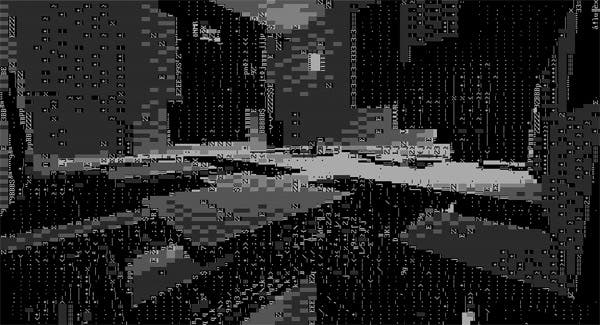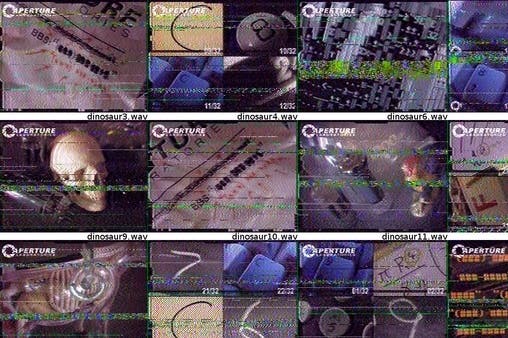"The first anyone had seen publicly of Portal 2 was relayed over this modem from 1987 from my kitchen"
Grr, ARG, it was Adam Foster all along.
In March 2010, Valve updated Portal with a mysterious patch that set fans on a trail of code-cracking and puzzle solving that ultimately led to the announcement of Portal 2.
The last layer of a convoluted ARG conundrum gave people a landline number in Washington near Valve HQ.
That phone number was Adam Foster's, he told me recently, and it was hooked up to an old BBS-capable PC with a modem from 1987, set up in his kitchen (information super sleuths have dug up before).
"It had to be in my apartment because the Valve phone systems were too modern for this system," he explained, "and when people connected to this and put the right username and password in, it relayed ANSI art versions of Portal 2 artwork.
"The first anyone had seen publicly of Portal 2 was relayed over this modem from 1987 from my kitchen."
Adam Foster landed a job at Valve in 2008 following his work on celebrated Half-Life 2 single-player add-on package Minerva: Metastasis, the story of which I delved into last week.
It was the nature of his announcing his employment to Valve using an ARG that started him on the path of becoming Valve's go-to ARG person.
So when an opportunity arose for Valve to tease something in GameInformer magazine in 2010 that would get "extreme fans of Portal" excited, it was Adam Foster who raised his hand.
"Essentially one thing led to another and we ended up adding these radios to the first Portal - updating it over Steam - and you'd pick up a radio and it'd just be making some kind of noisy buzzing noise, just kind of radio interference, and you'd walk around in the world with this radio and you'd get to particular locations and you'd get a stronger signal, and you'd pick up say Morse code transmissions - this funny kind of warbling, beeping noise, flowscan..." and on and on he went, presuming I understood.
Through Portal you'd go, accumulating "what looks like really noisy pictures from security cameras with numbers and letters in". And with those you could work out an MD5 hash of a phone number - his phone number.

"This many multi-million dollar project: I helped announce it in a form a computer from the late 1980s could understand," he said.
"It's one of the most surreal moments of my life, sitting next to this PC, listening to the modem. I don't know what the phone company thought I was doing - it was permanently engaged. Someone would hang up - was essentially kicked off - after five minutes, and someone else would immediately connect. And this thing was going absolutely constantly for days - I think we left it up for a few weeks in total.
"I figured out how much data it transmitted," he added. "It's over 13 megabytes of data, over a modem from 1987, which suddenly makes it more impressive." Portal 2 was announced for a hardware budget of less than $100, "which was kind of a bargain" - an understatement to say the least.
But there was one unsettling moment when Valve suddenly panicked and cried leak.
"Someone took this ANSI art image and traced over it and drew one of the co-op robots using this thing as an inspiration," Foster explained, "and got so terrifyingly close to the real thing that we initially thought there had been a leak, that some concept art had escaped."
It hadn't leaked, of course, it was just one person figuring it out.
"It's one of the most surreal moments of my life, sitting next to this PC, listening to the modem."
Adam Foster

The ARG clearly proved popular within Valve because the company would go on to do another one - Potato Sack - that spanned 13 indie games and culminated in early access to Portal 2 when it was released in 2011. Foster wasn't involved with that one.
"I wouldn't be surprised if there's stuff like that in future," he said - and he's confident he'll be involved.
"I think I will get to do it - I will make sure I'm in the right place at the right time. I still get questions like, 'Adam, I want to do this mini ARG thing.' It's like ooh I have ideas - I've got loads of ideas bubbling around in my head.
"I won't give any away because it's the answers to future puzzles, but some have levelled out on budgetary demands."
Those are ideas such as putting a CubeSat into orbit and having it relay radio data - an idea that would cost a mere $50 million, "maybe". He's ruled that one out, hence him talking about it. "I think that might be slightly beyond the standard advertising budget..." he said. Mind you, the asteroid mining Planetary Resources company is located pretty close to Valve, if not in the same huge office building (I've had a look but I can't tell for sure).
Foster's also the proud owner of a military teletype from the mid-1980s, "thanks to eBay and slightly too much beer". "It's kind of the exact model used on what was it, a B-1 [Lancer] nuclear bomber receiving launch codes to essentially destroy the world," he said. "And it wasn't particularly expensive. It mostly works. It cost $300 - $50 on transporting the thing across the US - it's heavy!"
It's at Adam Foster's (now famous) house (and kitchen) now, and getting it working is his long-term project. Ideally he wants to interface it with a modern computer so he can read his emails on it, in big important military capital letters.
Would he consider using it for Valve's next ARG, should be be in charge of it? "Possibly."
Exactly what he is working on at the moment is unclear - he couldn't say. But consider his background making Half-Life 1 and Half-Life 2 mods, and then being hired to work on the MIA Half-Life 2: Episode 3, and the suggestion is overtly Half-Life 3 - and perhaps its ARG?
Do your worst, Foster.

